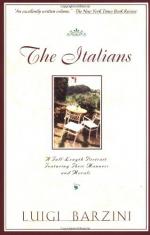In the long, narrow street of San Simone, behind the cathedral of San Martino, stand the two Guinigi Palaces. They are face to face. One is ditto of the other. Each is in the florid style of Venetian-Gothic, dating from the beginning of the fourteenth century. Both were built by Paolo Guinigi, head of the illustrious house of that name, for forty years general and tyrant of the Republic of Lucca. Both palaces bear his arms, graven on marble tablets beside the entrance. Both are of brick, now dulled and mellowed into a reddish white. Both have walls of enormous thickness. The windows of the upper stories—quadruple casements divided, Venetian-like, by twisted pillarettes richly carved—are faced and mullioned with marble.
The lower windows (mere square apertures) are barred with iron. The arched portals opening to the streets are low, dark, and narrow. The inner courts gloomy, damp, and prison-like. Brass ornaments, sockets, rings, and torch-holders of iron, sculptured emblems, crests, and cognizances in colored marble, are let into the outer walls. In all else, ornamentation is made subservient to defense. These are city fortresses rather than ancestral palaces. They were constructed to resist either attack or siege.
Rising out of the overhanging roof (supported on wooden rafters) of the largest and most stately of the two palaces, where twenty-three groups of clustered casements, linked by slender pillars, extend in a line along a single story—rises a mediaeval tower of defense of many stories. Each story is pierced by loop-holes for firing into the street below. On the machicolated summit is a square platform, where in the course of many peaceful ages a bay-tree has come to grow of a goodly size. About this bay-tree tangled weeds and tufted grasses wave in the wind. Below, here and there, patches of blackened moss or yellow lichen, a branch of mistletoe or a bunch of fern, break the lines of the mediaeval brickwork. Sprays of wild-ivy cling to the empty loop-holes, through which the blue sky peeps.
The lesser of the two palaces—the one on the right hand as you ascend the street of San Simone coming from the cathedral—is more decorated to-day than any other in Lucca. A heavy sea of Leghorn hats and black veils, with male accompaniments, is crowded beneath. They stare upward and murmur with delight. Gold and silver stuffs, satin and taffeta, striped brocades, and rich embroideries, flutter from the clustered casement up to the overhanging roof. There are many flags (one with a coat-of-arms, amber and purple on a gold ground) blazing in the sunshine. The grim brick facade is festooned with wreaths of freshly-plucked roses. Before the low-arched entrance on the pavement there is a carpet of flower-petals fashioned into a monogram, bearing the letters “M.N.” Just within the entrance stands a porter, leaning on a gold staff, as immovable in aspect as are the mediaeval walls that close in behind him. A badge or baldric is




